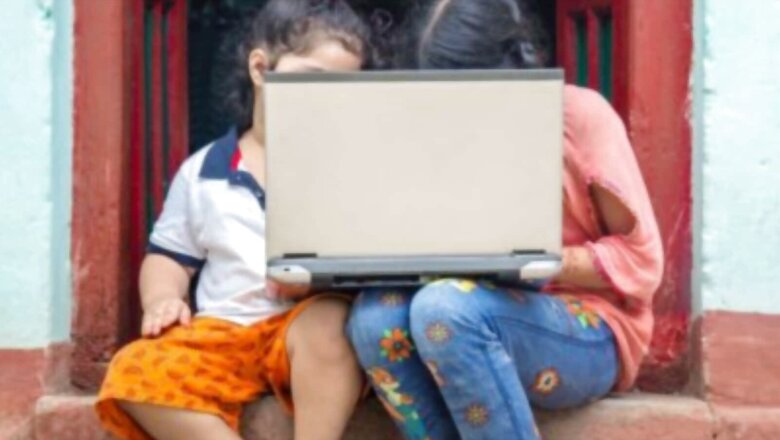
views
When the world closed ranks against a little-known virus in March 2020, closure of schools along with everything else was quite justified. Two years down the line, with the benefit of experience of COVID-19 itself, as well as observing children spend a long time mostly indoors, the data is disturbing.
COVID-19 among children has proved to be an extremely mild disease, with global data suggesting that the risk of severe infection in children is less than 1 per cent, that too mostly in kids with underlying chronic disease or immunosuppression. Children under 10 and particularly under 5 years of age are least affected. However, prolonged school closures and lack of outdoor time have spawned a new and unseen pandemic altogether, by way of lifestyle diseases that could cause graver long-term impact among children than the virus itself.
Ever since phone and iPad screens have replaced classrooms, children’s lifestyles have altered to their detriment. There are no more early morning start and the dash to the bus stop. Journey time to and from school, and the gamut of activities, sports, group-projects, music, elocution, even the simple joy of dashing up and down staircases is gone. Children now awake minutes before online classes, grab their devices, and stay sedentary more or less through the day. Our 7- and 12 year-olds are living like middle-aged executives, something that is against the basic nature of childhood itself. Devices that offer virtual classes also offer social media, and an unending array of inane videos and content. Children are glued to their devices now, for work, for play, and everything in between. The average screen-time has increased from 2.5 hours pre-COVID to 7 hours now.
To go with this surge, there is a corresponding and predictable drop in physical activity. How much can a child exercise at home, without friends or sports facilities?
Worse, research indicates that the number of hours children spend watching TV correlates with their consumption of the most advertised goods, including sweetened cereals, sweets, sweetened beverages and salty snacks.
ALSO READ | In COVID Times, Why It is Dangerous to Mistake Information for Education
As pediatricians, we are amidst a tsunami of childhood obesity. The numbers have almost tripled in the last two years. Studies have shown association between increased body mass index (BMI) and body fat percentage as screen time increased. Another study has shown association between screen time and increase in snacking and a consequent increase in weight. Increased screen time also results in disturbed and poor sleep that further perpetuates weight gain in children.
Weight gain by itself has a cascade of consequences. Children experiencing obesity have a higher risk of depression because of stigma and isolation and eat in response to stress to a greater degree than normal-weight peers. Childhood obesity is akin to a ticking time bomb ready to explode anytime into complications like diabetes, hypertension, fatty liver and metabolic syndrome among the future productive population of our country.
On another note, the increased BMI (body mass index), prolonged screen exposure and stress associated with the lockdown have also led to a significant rise in cases of precocious puberty, especially in girls. Many parents have brought their 6-9 year-old girls with complaints of early onset of puberty, and 8-year-olds getting their periods to paediatric endocrinologists in the last two years. There has been a three-fold rise in such cases.
Prolonged school closure has kept a majority of children indoors for the last two years and we are seeing an alarming number of symptomatic cases of Vitamin D deficiency across all age groups. Presentations have varied from convulsions and tetany due to low calcium levels secondary to vitamin D deficiency to severe leg pains, deformities and inability to perform simple daily activities like climbing up and down the stairs or even walking for half an hour.
The human body accumulates 30 per cent of its whole bone mineral density during adolescence. Exercise and physical activity are major drivers for this process. By keeping children indoors for so long, we have also compromised on their future bone strength.
Finally, stating the obvious, the impact on our children’s eyes. The incidence of myopia had increased from 16 per cent in 2020 to 27 per cent in 2021 and is directly related to increase in average screen time. The worst affected are the smaller children in 5-10 year age group, who have had to adopt the screen-based lifestyle so early in life. Dry eye and headaches are other common consequences of online stay-at-home schooling.
We do not know what course COVID-19 intends to chart. It may wane on predicted lines, or it may surprise us yet again. From what we have seen of it thus far, however, we find that the consequences of keeping children indoors to protect them from the virus are perhaps going to be a lot more serious than the virus itself.
Dr Manpreet Sethi is pediatric endocrinologist at Max Hospitals, Delhi-NCR. The views expressed in this article are those of the author and do not represent the stand of this publication.
Read all the Latest Opinion News and Breaking News here



















Comments
0 comment